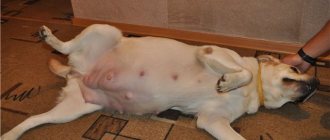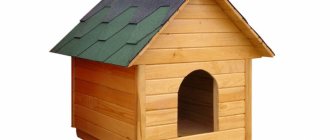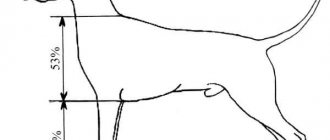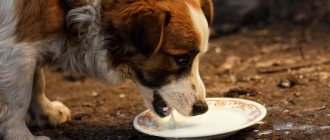Why do you need Labrador training?
Dogs are smart. However, without developing its natural potential, an adult dog can cause a lot of trouble. Animals that do not know what training is can ignore the owner’s requests, show spontaneous aggression, bark at passers-by, cars, and chase cats.
This is interesting: Rating of dogs by intelligence
This is interesting: Rating of dogs by intelligence
Some breeds were created for specific functions. Dogs have developed instincts of hunters, shepherds, and fighters. Therefore, it is important that the dog knows how to control emotions and strength. Otherwise, the dog will become dangerous to the family and society.
Training the dog will solve the problem. Mastering at least the basic level will turn the animal into a well-mannered, manageable pet that does not cause discomfort to others.
Labradors are intelligent and easy to train. Problems rarely arise during training with dogs.
This is interesting: Does a nickname affect the fate of a dog?
Pet care
A balanced diet is the key to a healthy dog
The retriever's nutrition should be comprehensive and thoughtful. You can use a dry food system or products of natural origin, but you cannot mix food systems. Labradors sometimes like to steal food, so the food that may be available to the pet should not be harmful to the pet.
Lack of nutrition can cause an individual to lose weight. Overfeeding is not beneficial - the dog begins to gain weight. If there are any changes in weight, you should immediately pay attention to your diet and possibly review your diet.
Labradors are often fed based on the desire to please. This cannot be done; it will disrupt a strictly balanced diet. The owner must be strict regarding nutrition.
Walks
The mobility and activity of the representatives of the breed is an indisputable fact. The animal's energy must be directed to physical exercise and frequent walks, otherwise they will begin to splash it out on other activities that are unlikely to be convenient for the owner.
Morning and evening walks are mandatory. They must take a long time. It's not easy to spend a lot of time outdoors with a dog - they need to be played with, especially if they're a puppy.
Conditions for keeping
Peculiarities:
- Frequent and long walks. You can't lock your pet up all day. Such a dog needs space to play and fresh air. The area of a private house will become comfortable, but you cannot lock the dog in an enclosure - loneliness will be destructive for him.
- Careful coat care. You need to walk the dog and brush it. Labrador shedding is characterized by a large amount of fur. But if you comb the dog correctly and often and carry out regular cleaning, then this problem will not cause the owners much difficulty.
- "Place". The pet needs its own place. It should not be small, the dog needs to feel free. Such a place should not be very secluded; the dog loves communication.
General rules for training a Labrador
There are different methods of conveying new information to the dog. Working plans are built based on the characteristics of the breed and the individual needs of the dog. However, there are conditions that must be complied with.
Forbidden:
- move on to new commands without mastering the old ones;
- Conduct the first 3 workouts in a noisy place where there are a lot of irritating factors;
- overwork the dog;
- get nervous, yell at the dog;
- Do not reward your pet with treats for doing the right thing.
Neglecting the recommendations of specialists will negatively affect the work process and delay the result.
Training should evoke positive emotions in your Labrador puppy.
Is my property suitable for Labrador?
According to the Kennel Club Breed Standard, the Labrador is a breed for rural areas. Its original purpose is hunting. Dogs of this breed are very active; they need to run and frolic in nature. In addition, the Labrador is a medium-sized breed, which, combined with high mobility, requires a certain amount of space. A country house with an adjacent garden is ideal for a Labrador to live. The conditions of even the most spacious apartment are unacceptable. And regularly climbing the steps of a multi-story building can lead to deformation of the dog’s skeleton. Small breed dogs are more suitable for apartment conditions.
General training course
Basic dog training methods are based on the principles presented by Academician I. Pavlov. The owner’s goal is to develop reflexes in the animal that are responsible for determining further behavior.
When training a Labrador, the development of the pet's senses is of great importance. The dog’s ability to see the world in black and white does not limit the dog’s potential in recognizing human movements and facial expressions. But the Labrador has problems identifying shades.
This is interesting: How to accustom a Labrador to a home environment?
In the absence of health deviations, the animals’ hearing is ideally developed. Dogs hear quiet sounds and rustling sounds.
A dog's sense of smell is 10 thousand times stronger than a human's.
The Labrador is able to distinguish those odors that people cannot even remotely smell.
During classes, you need to pay attention to the psychological characteristics of the ward, analyze the actions of the dog.
Types of possible dog reactions:
- physiological;
- protective;
- food;
- approximate.
The tendency to a certain type of behavior depends on genetics and the upbringing of the individual. In order to correctly take into account the characteristics of your pet and choose effective training methods, it is necessary to conduct a test.
Task conditions:
- You will need 2 assistants.
- In the morning the dog is placed in an unfamiliar environment. Shelters must be provided there. A landfill or a country yard would be suitable.
- To prevent the pet from running away, it is tied.
- The owner leaves the area.
- The partner, passing close to the Labrador, begins to make noise, and after 5 minutes leaves.
- The second person pretends to attack the animal, waving his arms, screaming.
- A bowl of food is placed in front of the dog. Repeatedly portray aggression.
After each stage, it is necessary to observe the dog’s reaction. This will reveal the type of prevailing behavior. If, despite the conditions, the dog tries to quickly empty the bowl, it means that the dog has a predominant food reaction.
Labradors tend to exhibit protective reflexes, adapt to the situation with lightning speed, and defend themselves by barking.
Level of emotionality of the animal:
| Temperament types | Characteristics of the dog |
| Choleric | Restless, efficient |
| Sanguine | Energetic, balanced, easy to learn |
| Phlegmatic person | Slow, motionless. Reflexes are difficult to develop, but are remembered for a long time |
| Melancholic | Easily hurt, relaxed. Difficult to educate |
Labrador retrievers can have mixed temperaments. Therefore, observations should not be stopped during the training period. Neglecting the rule, you can make mistakes that provoke rapid fatigue of the dog, fear of the owner, or aggression, neuroses. Failure to adhere to the training schedule, ignoring the dog’s characteristics, and consistent use of opposing commands lead to a similar result.
Setting up an adult Labrador with new owners
Author Anton Staroverov Reading time: 3 min. Published 11/25/2019
Hello. I am taking a 5-year-old Labra girl, she has given birth twice. How quickly will he get used to a new place? Thank you!
Answer
Labrador dogs love all family members due to their peaceful nature. They are distinguished by loyalty, playfulness, and good nature.
Having a steely endurance, they become wonderful companions for families with children. Labradors mature slowly; a physically mature dog remains a puppy until the age of two. They respond well to training. When an adult Labrador gets into a family, it has the dignity of being trained. You won't have to teach your new pet the knowledge he needs to learn. All you have to do is consolidate your existing skills to suit your own requirements. You will save time and put effort into helping your newly made friend adapt to their new place of residence.
Dog behavior in unfamiliar territory
A change of environment, the loss of a beloved owner is a very stressful situation. Not all representatives of the breed have the same behavior when moving to an unknown location or to new people.
As soon as you bring it home, be prepared for the animal to react with distrust. React to “surprises” presented calmly.
The dog will instinctively be wary because it has already lost a close friend - its owner. He misses his old home, his former family. A creature subject to stress does not show its best side: barks loudly, howls, damages furniture and things, relieves itself in inappropriate places. You cannot physically punish or swear, she will become embittered and feel like an enemy in you.
Setting up in a new place
Observe where your new friend feels comfortable. Determine the place where the dog will sleep. The dog first gets used to the comfortable conditions of the resting place - personal territory. The animal must feel that its personal space is protected from strangers, and no one claims it. You cannot limit your pet's movement to a designated area. This is unacceptable for any breed.
The organization of the food and water intake area is important. It is possible that the dog will not want to eat at first. Don't try to feed. When she gets hungry, she will show interest in communication. Try hand-feeding, gradually showing him a permanent feeding location.
Helping a four-legged friend
To support a new family member, be active and perform simple actions:
- Give your ward time: communicate, show affection, take a walk, play. Earn favor and trust.
- Find out the nuances of the former contents, behavioral habits, food preferences. The information received will help form an idea of character.
- Get your dog used to a schedule that suits you. Set the exact time for getting up, eating, playing. The daily routine should be acceptable for you and the dog. If the animal wakes you up early, gradually re-arrange it. Go out for a walk later than on the previous day. The effect of observing time restrictions will be as expected. The dog will easily get used to the established routine.
- Set house rules. Show that there are established standards in your home that must be followed. Make only reasonable demands to her. For example, do not allow sleeping on the sofa, showing pity, planning to prohibit lying on upholstered furniture, just because you do not welcome pets in people’s recreation areas.
The character of the bitch who gave birth
For a female, motherhood is of great importance. Bearing offspring and the process of childbirth play a primary role in the development of a dog as a person. A bitch who has not experienced motherhood is immature. Behavior is dominated by extreme playfulness and excessive aggression. The female gains considerable experience by feeding and raising puppies. The bitch who gave birth to puppies is balanced and confident. Tolerates the adaptation period quickly and calmly.
The period of adaptation is individual
The dog gets used to unusual conditions from 5-7 days to 2-3 weeks. In difficult situations it will take several months. Young individuals with a stable nervous system cope more quickly with shock. Much depends on the fact how the animal will perceive the new owner, and what approach the owner will find to establish relationships. A dog is an individual and reacts to external stimuli in its own way.
dogcentr.ru
Possible difficulties
It is recommended to start working with a dog from 2 months. In adulthood, during training, many owners encounter difficulties arising from the impulsiveness of the breed. Dogs are often distracted, try to escape from classes, and prefer games.
Labradors are able to outwit the owner by luring out treats. At the same time, dogs make ideal hunters, guides, and trackers. Dogs are also capable of guarding skills, but with difficulty.
Labradors are equally trainable at any age. Able to remember a command 2-5 times.
Sometimes puppies already perform complex tasks at 3 months of age.
Leash and muzzle training
No matter how affectionate your pet may be, the requirement that the dog must be on a leash in public places has not been canceled. To avoid whims, it is best to teach walking on a leash from 3 months, gradually.
First, choose a comfortable collar and muzzle for your baby. It should not press, pinch or be too loose. This can lead to chafing around the neck. It is worth giving preference to quality materials. Please note: the dog will soon outgrow these accessories and will have to be selected again.
The purchased muzzle and collar should be given to the baby to sniff (this is where the quality of the materials comes in handy: a strong smell can scare away the dog). Let him get to know him properly. And if he suddenly decides to give it a try, command “Fu.”
When the introduction has taken place, get the animal to stick its head inside (it is useful to place a treat inside). Praise when the puppy is in the collar, and if he tries to take it off, distract him with play.
At first, the baby should not wear the collar for long. Talk kindly to your Labrador, and it’s better not to try to tug on the leash while controlling him. Just follow the puppy, giving him freedom of choice. Then the dog will not receive psychological trauma and will calmly get used to this equipment.
Nuances of education
Well-planned training is 50 percent of success. The trainer needs to remember that if there is an excess of feelings, it is difficult to achieve the dog’s obedience. And the owner’s persistence will cause emotional suppression of the pet.
Before the lesson, the Labrador should have played enough and be a little tired. A leisurely walk on a leash will distract your dog from entertainment. After 10-15 minutes you can try to call your pet. If the Labrador immediately responds to the call, it is ready for training, but ignores its nickname - the nervous system has not yet returned to its normal state.
For boys
When working with male dogs, you need to learn how to keep the dog's attention on you. The owner should give priority to dogs running past.
The hardest thing for Labradors - boys - is to resist the temptation to be distracted by a playful lady during the period of heat.
Girl
Bitches have their own difficulties. The trainer has to adapt to frequent mood swings or learn to stabilize the emotional swings of the four-legged animals. Instability is associated with hormonal levels.
Expert opinion
Anna Abramenko
An avid dog lover. Experience in veterinary medicine since 2009.
Ask a Question
When your pet becomes distracted, it is better to postpone training. The best option is to start raising a girl at 2 months.
How to prepare the house
Labradors are one of the famous dog breeds. If you need to choose one word as a description, then this word would be friend.
The puppy will need:
- Place to sleep and mattress;
- Feeding area;
- Stock of special food;
- Bowls;
- roulette leash with collar;
- Toys;
- First aid kit.
Before bringing a puppy into the house, you need to remove carpets from the floor, remove all small objects, needles, threads that the baby can swallow, and securely hide electrical and telephone wires, chemicals and shoes. It is important to immediately train the puppy to go to the toilet, and not allow him to do things anywhere.
Command training
Having trained a Labrador puppy to use the toilet, behave properly on the street, and eat, you need to delve deeper into mastering basic tasks.
- “Place” is one of the basic commands that every dog should know. Having voiced it, you need to take the pet to its bed. Sudden movements are not allowed; it is allowed to hold the Labrador by the collar. After placing the dog on the bedding, you need to give him a treat. After completing the reception, it is repeated until the pet remains in its place.
- "Sit". The owner comes close to the dog, sits the Labrador down, applying pressure on the back with his palm. After this, you need to say the command loudly. The puppy has completed the task and receives a treat.
- "Lie". Lessons are conducted in the same way. Trainers place the dog on the floor, resting their hand on the croup.
- "Stand". When the dog is sitting, you need to pull it by the collar with one hand, show an upward gesture with the other, and indicate the command verbally.
- “Bring it.” Chain of actions: throw the ball, ask your four-legged friend to catch it and return it to the owner.
- "To me". This command is necessary on walks. If the dog does not master it, then the Labrador cannot be let off the leash. Practice the reflex in natural home conditions. When calling the dog, they give a treat.
- "Near". During the walk, you need to keep your pet on a short leash, pronounce the command “nearby”, and offer treats.
- "Ugh". A piece of his favorite food is placed in front of the animal. As soon as your pet reaches for a treat, you need to say “ugh” and hit it on the face with a rolled-up newspaper. It doesn't hurt, but it will cause discomfort for the dog.
- "Voice". It is necessary to ensure that, on demand, the animal begins to bark. Labradors quickly understand the essence of the trainer's wishes. To teach the “voice” command, it will take from 2 to 10 training sessions.
- "Give". The drill is taught through fun. While playing with a toy, you need to ask the dog to give it back.
- “Fetch” is one of the favorite tasks of dogs. They begin to perform it after the dog learns the commands: “fu”, “come to me”. This will make it easier to manage the animal on the street. It is necessary to show the pet a stick (ball) and throw it a short distance, let the Labrador off the leash, and shout “fetch.” The dog must bring the item and receive a treat.
Expert opinion
Anna Abramenko
An avid dog lover. Experience in veterinary medicine since 2009.
Ask a Question
Commands must be repeated daily, bringing the execution to automaticity. It is important to develop a strict tone and a confident look.
Labrador's loyalty - Raising puppies - Labrador.ru dogs
Labrador fidelity – Raising puppies – Labrador.ru dogs – retrieversJump to content
Mark Zagaruk 1
- Newbie
- Users.
- 1
- 30 posts
- City:Starobelsk
Dasha Shuleko 8,343
- Aksakal
- Users.
- 8,343
- 11,031 posts
- Sex:Female
- City:Moscow, Vykhino
Natalie Chuck and Cash 422
- Active participant
- Users.
- 422
- 1,035 posts
- Sex:Female
- City:Moscow
Vlada&Rachel 224
- Active participant
- Users.
- 224
- 1,599 posts
- Sex:Female
- Region:Chelyabinsk region
- City:g. Chelyabinsk
Mark Zagaruk 1
- Newbie
- Users.
- 1
- 30 posts
- City:Starobelsk
Cherkatosha 42
- Companion
- Users.
- 42
- 288 posts
- Sex:Female
- City:Moscow
Black and White 406
- Forum resident
- Users.
- 406
- 2,003 posts
- Sex:Female
- City:Moscow region
Clumber 11,698
- Aksakal
- Users.
- 11,698
- 8,580 posts
- Sex:Female
- City:Moscow, VDNH
Sergey+Nika 963
- Active participant
- Users.
- 963
- 1,364 posts
- Sex:Male
- City:St. Petersburg
Natalia and Steve 431
- Active participant
- Users.
- 431
- 1,087 posts
- Sex:Female
- City:Moscow
Cherkatosha 42
- Companion
- Users.
- 42
- 288 posts
- Sex:Female
- City:Moscow
Deniska 19,292
- Aksakal
- Users.
- 19,292
- 29,257 posts
- Sex:Female
- City:Moscow, Begovaya metro station, Alexandrov, Vladimir region
*vikka* 6,142
- Aksakal
- Users.
- 6,142
- 5,178 posts
- Sex:Female
- City:Moscow
Mad_Panda 432
- Active participant
- Users.
- 432
- 1,142 posts
- Sex:Female
- Region:Moscow region
- City: Pushkino MO
Juliarex 375
- Active participant
- Users.
- 375
- 1,555 posts
- Sex:Female
- Region:Nizhny Novgorod region
- City:Nizhny Novgorod
Dasha Shuleko 8,343
- Aksakal
- Users.
- 8,343
- 11,031 posts
- Sex:Female
- City:Moscow, Vykhino
labrador.ru
Punishment and reward
The behavior of even the most well-mannered dogs sometimes causes criticism. In order for the puppy to understand his mistakes, you need to correctly point out them. It is important to focus on your pet’s good deeds. This will reinforce positive behavioral skills in your Labrador.
It is necessary to think over a scheme of praise and punishment. Both methods must be present in the process of developing the Labrador's character.
Expert opinion
Anna Abramenko
An avid dog lover. Experience in veterinary medicine since 2009.
Ask a Question
Puppies are often mischievous during childhood. This requires a prompt response from the owner. You need to let the animal know that it did something bad. It is permissible to point out the damaged item, say strictly “ugh”, and not play with your pets for the next hour.
The baby relieved himself in the house because the owner did not take him for a walk - you cannot scold a pet. The man himself provoked such an act.
When a dog willingly follows the owner’s commands, it deserves a reward and should receive it immediately - a treat, praise.
Yelling at the animal or hitting it is strictly prohibited. Otherwise, he will grow up to be a frightened dog with mental problems.
Labrador retriever: not only a family friend, but also a fearless protector
It all started with the fact that my child had been asking for a dog for a long time. For me, an animal in the house is a disaster. The most I agreed to was to get a hamster without much hassle. And here is such a responsibility. Moreover, the son did not ask for any dog, but a Labrador. When I read about this breed, I grabbed my head: active and playful, they sweep away everything in their path and are quite capable of destroying a house. I remembered a friend of mine who owned a Labrador, and decided to find out everything about the breed first hand.
Alina has long wanted to get a dog. And one day an acquaintance suggested giving her a Labrador for her birthday. There was no limit to her joy - this was the kind of dog she had always dreamed of. Although Alya lived in a private house, she did not need a security guard, she wanted to have a companion dog and just a friend:
“We went to the Labrador Owners Club to pick up a dog with a pedigree. Among all the puppies, I liked Trevor. I looked into his eyes and realized that I was gone. He looked at me with such trust and devotion that I immediately fell in love with this puppy. It was love at first sight. Labradors themselves are very kind and affectionate, but Trevor simply became my youngest child. We experienced all the delights of growing up - there were ruined shoes, and even attempts to gnaw my ear in the middle of the night. The thing is that the Labrador is a very playful dog, he needs a lot of attention and care. If he is bored, he tries to attract attention in this way. But over time, the dog matured, and this problem disappeared. In the house, Trevor felt like a complete master; he was never on a leash and always walked freely around the yard. And then one day there was a commotion behind the gate. As we found out later, a woman passing by was attacked by a stray dog. Trevor rushed to the gate and began barking at the tramp. And then the dog switched to my Labrador. That dog was a fighting breed, he grabbed Trevor's face with a death grip. I ran out to the noise and could barely separate the dogs. The Labrador got hurt and had to be taken to the vet, but the stray got it too. This is how it turned out that my Trevor is not just a family friend, but also a fearless defender who was not afraid to defend his territory.”
Alina said that there is nothing complicated in caring for a Labrador, you just need to actively walk him. They are also terrible gourmands and love to eat, they even try to steal something from the table. But you need to monitor your dog’s diet and not overfeed, as they are prone to obesity. Labradors are very friendly and get along well with other animals. Here's what Alya says:
“Once I picked up a dying mongrel dog on the street. I brought it home and went out. I was worried that Trevor would be jealous and wouldn’t get along with his new pet. But the Labrador immediately made friends with Dora, took care of her at first and even allowed her to eat from his bowl. When Dora grew up, we spayed her. And recently my daughter also brought a cat. At first we kept her separately, we were afraid that she wouldn’t make friends with dogs. But this member of the household was received well, and now we have a big, friendly family.”
In addition, we discussed the problem of stray dogs. The only way to reduce their numbers is sterilization. Therefore, we turned to an animal protection organization and provided financial assistance for the sterilization of stray animals. And we encourage all concerned to take part in this good cause.
Here's the story. Alya also said that Labradors love to swim. In this we are similar, and I will soon have a companion for trips to the river. Now I have definitely decided that if I get a dog, it will only be a Labrador.
Read further:
Labrador Retriever: friendly and loyal pets
Markusha
The Australian Bandog is a protector and companion with a strong character.
Alabai: fearless and resilient defenders
“Beethoven” is a faithful friend both in cinema and in life
American Pit Bull Terrier: fearless protector and devoted friend
Basic mistakes
During training, you should not overdo it with the same commands. Labrador Retrievers can become bored with the monotony of tasks. Numerous fetchings will provoke a refusal to bring toys to the owner.
If the dog gets off the leash and runs, there is no point in catching up with him. You need to shout “to me” in a demanding tone. Chasing can be perceived as a game by your Labrador.
Dogs should not be allowed to stay in the water for long periods of time. Animals love to swim; when they feel out of control, they will ignore the trainer’s calls and go ashore.
Is it worth buying an adult dog?
If a family decides to take an adult Labrador into their home, they must first weigh some circumstances:
- Have the new owners ever interacted with similar breeds of dogs?
- Observe the pet in a familiar environment;
- Find out if the Labrador has had contact with children and pets;
- Does she have any bad habits (she may have to stop going to the toilet at home);
- See how the dog behaves on the street, how controllable it is.
Tips from dog handlers
Recommendations that dog handlers do not recommend neglecting:
- Study the characteristics of the breed before purchasing a puppy. This will allow you to competently educate the creature and build an effective work scheme.
- Choose a suitable place to study. The room, the courtyard, should be quiet, spacious, and comfortable.
- Walk your dog regularly.
- Do not allow assault, even if the dog is very guilty.
- Monitor the schedule of necessary vaccinations. Visit veterinary clinics.
- Express dissatisfaction or praise fairly, after analyzing his actions.
- Give commands in a stern, non-rude tone. The dog should want to obey, not be afraid.
- Provide the animal with sufficient, balanced nutrition.
- Find time for tenderness every day. Don't neglect the opportunity to pet your pet. This will make the relationship between dog and owner warm and trusting.
- Don't give up on classes. Acquired skills require constant reinforcement.
Following the advice of dog handlers, even for novice dog breeders it will not be difficult to get a disciplined, wise dog.
Having mastered the basic skills of the training course, you need to move on to complicating the program. Labradors have great potential. With the right approach of the owner, it can be fully revealed. Then the dog will become not just a friend, but the main protector and assistant.
Need advice from experienced dog breeders. — Communication — Labrador.ru dogs
Need advice from experienced dog breeders. — Communication — Labrador.ru dogs — retrieversJump to content
isida_ko 0
- Newbie
- Users.
- 0
- 3 posts
- Sex:Female
- City:Kazan
1,560
- Active participant
- Users.
- 1,560
- 1,581 posts
- Sex:Female
- City:Novosibirsk
Lena and Ray 1,569
- Forum resident
- Users.
- 1,569
- 2,021 posts
- Sex:Female
- City:Moscow
Olivia 11,936
- Aksakal
- Users.
- 11,936
- 9,337 posts
- Sex:Female
- City:Moscow nearby
Irina&Diana 5,112
- Aksakal
- Moderators
- 5,112
- 6,518 posts
- Sex:Female
- City:Moscow - South-Western Administrative District
isida_ko 0
- Newbie
- Users.
- 0
- 3 posts
- Sex:Female
- City:Kazan
Lina-Lina 9,287
- Aksakal
- Moderators
- 9,287
- 16,816 posts
- Sex:Female
- Region:Tyumen region
- City:Ishim
isida_ko 0
- Newbie
- Users.
- 0
- 3 posts
- Sex:Female
- City:Kazan
Zhanna and the Dogs 4,211
- Aksakal
- Users.
- 4,211
- 7,672 posts
- Sex:Female
- Region:Moscow region
Mosfilmka & Remy 15,150
- Aksakal
- Users.
- 15,150
- 8,680 posts
- Sex:Female
- City:Moscow, JSC - Vladimir
Sheile 1,216
- Active participant
- Users.
- 1,216
- 1,584 posts
- Sex:Female
- City: St. Petersburg, Primorskaya metro station
Lina-Lina 9,287
- Aksakal
- Moderators
- 9,287
- 16,816 posts
- Sex:Female
- Region:Tyumen region
- City:Ishim
Irina&Diana 5,112
- Aksakal
- Moderators
- 5,112
- 6,518 posts
- Sex:Female
- City:Moscow - South-Western Administrative District
ICQ and Dogs 6,569
- Aksakal
- Users.
- 6,569
- 8,398 posts
- Sex:Female
- City:Moscow, VAO, Preobrazhenka
Ksenik 2.104
- Active participant
- Users.
- 2,104
- 1,909 posts
- Sex:Female
- City:St. Petersburg
Jardin 113
- Companion
- Users.
- 113
- 859 posts
labrador.ru
Video tutorial on training
Proper education of a Labrador, building relationships with your pet, an effective approach to learning commands. All this is presented in a video tutorial based on the experience of dog handlers.
DESCRIPTION OF THE BREED
The Labrador Retriever is a well-built, muscular dog of large size. On average it grows to 55-57 cm, with a maximum weight of up to 36 kg. The head is proportional to the body, the skull is wide. Standard-sized eyes are most often brown.
The dog's ears are medium in size, set closer to the back of the head and fit snugly to the head. Powerful neck, straight back with a strong, even spine, tail tapering from base to tip. The dog has good strong limbs, paws of a regular round shape. The hair is hard, short, with a characteristic undercoat.
REMEMBER! Labrador Retrievers (especially fawn colored ones) are often confused with Golden Retrievers. The differences between them can be found in their coats; retrievers have golden waves. Whereas Labradors are smooth-haired. The Labrador's head looks more massive because they are designed to hunt larger game.
On average, dogs can please their owner for 12-13 years.











